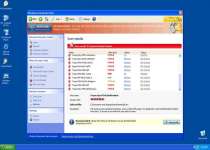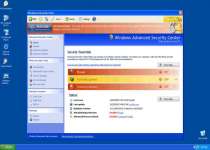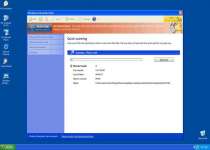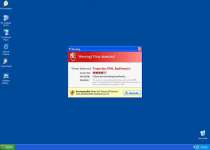Windows Enterprise Suite
Posted: October 29, 2009
Threat Metric
The following fields listed on the Threat Meter containing a specific value, are explained in detail below:
Threat Level: The threat level scale goes from 1 to 10 where 10 is the highest level of severity and 1 is the lowest level of severity. Each specific level is relative to the threat's consistent assessed behaviors collected from SpyHunter's risk assessment model.
Detection Count: The collective number of confirmed and suspected cases of a particular malware threat. The detection count is calculated from infected PCs retrieved from diagnostic and scan log reports generated by SpyHunter.
Volume Count: Similar to the detection count, the Volume Count is specifically based on the number of confirmed and suspected threats infecting systems on a daily basis. High volume counts usually represent a popular threat but may or may not have infected a large number of systems. High detection count threats could lay dormant and have a low volume count. Criteria for Volume Count is relative to a daily detection count.
Trend Path: The Trend Path, utilizing an up arrow, down arrow or equal symbol, represents the level of recent movement of a particular threat. Up arrows represent an increase, down arrows represent a decline and the equal symbol represent no change to a threat's recent movement.
% Impact (Last 7 Days): This demonstrates a 7-day period change in the frequency of a malware threat infecting PCs. The percentage impact correlates directly to the current Trend Path to determine a rise or decline in the percentage.
| Threat Level: | 10/10 |
|---|---|
| Infected PCs: | 5 |
| First Seen: | December 1, 2009 |
|---|---|
| Last Seen: | December 15, 2020 |
| OS(es) Affected: | Windows |
 Windows Enterprise Suite is a rogue anti-spyware program. WindowsEnterpriseSuite is considered to be part of the family of rogues which goes together with Volcano Security Suite. Research has proven how each of the above mentioned rogue program tends to make use of similar confusing ways so as to entice trustful computer users to purchase the full version of this deceitful security program.
Windows Enterprise Suite is a rogue anti-spyware program. WindowsEnterpriseSuite is considered to be part of the family of rogues which goes together with Volcano Security Suite. Research has proven how each of the above mentioned rogue program tends to make use of similar confusing ways so as to entice trustful computer users to purchase the full version of this deceitful security program.
Aliases
More aliases (29)
Use SpyHunter to Detect and Remove PC Threats
If you are concerned that malware or PC threats similar to Windows Enterprise Suite may have infected your computer, we recommend you start an in-depth system scan with SpyHunter. SpyHunter is an advanced malware protection and remediation application that offers subscribers a comprehensive method for protecting PCs from malware, in addition to providing one-on-one technical support service.
* See Free Trial offer below. EULA and Privacy/Cookie Policy.
Why can't I open any program including SpyHunter? You may have a malware file running in memory that kills any programs that you try to launch on your PC. Tip: Download SpyHunter from a clean computer, copy it to a USB thumb drive, DVD or CD, then install it on the infected PC and run SpyHunter's malware scanner.
Technical Details
File System Modifications
Tutorials: If you wish to learn how to remove malware components manually, you can read the tutorials on how to find malware, kill unwanted processes, remove malicious DLLs and delete other harmful files. Always be sure to back up your PC before making any changes.
The following files were created in the system:WE40ea.exe
File name: WE40ea.exeSize: 1.96 MB (1968640 bytes)
MD5: 9d0d0cc11fd83a4f6a65836745fee07a
Detection count: 96
File type: Executable File
Mime Type: unknown/exe
Group: Malware file
Last Updated: December 11, 2009
WEbf92.exe
File name: WEbf92.exeSize: 1.91 MB (1910784 bytes)
MD5: b7fa379e1e2a8eed0f097ea58a020cf4
Detection count: 94
File type: Executable File
Mime Type: unknown/exe
Group: Malware file
Last Updated: December 11, 2009
WEe9f0.exe
File name: WEe9f0.exeSize: 1.91 MB (1910784 bytes)
MD5: acc9f9fa4ddc8a952b0bed9b19f04567
Detection count: 83
File type: Executable File
Mime Type: unknown/exe
Group: Malware file
Last Updated: December 11, 2009
WE2e0e.exe
File name: WE2e0e.exeSize: 1.91 MB (1918976 bytes)
MD5: 22660ae24c96139ef2bc0c8ee927ed77
Detection count: 81
File type: Executable File
Mime Type: unknown/exe
Group: Malware file
Last Updated: December 11, 2009
WEc03f.exe
File name: WEc03f.exeSize: 1.92 MB (1926144 bytes)
MD5: 9590e9e1227548a6eab4bb033bdd48a6
Detection count: 75
File type: Executable File
Mime Type: unknown/exe
Group: Malware file
Last Updated: December 11, 2009
WE82f5.exe
File name: WE82f5.exeSize: 1.9 MB (1908736 bytes)
MD5: 87d71eb6beec7127cfc88d4e900a90e9
Detection count: 74
File type: Executable File
Mime Type: unknown/exe
Group: Malware file
Last Updated: December 11, 2009
WEccb0.exe
File name: WEccb0.exeSize: 1.89 MB (1897472 bytes)
MD5: 5178a2fd2832912cc5520aed886ecf7e
Detection count: 44
File type: Executable File
Mime Type: unknown/exe
Group: Malware file
Last Updated: December 11, 2009
WEc584.exe
File name: WEc584.exeSize: 1.95 MB (1957376 bytes)
MD5: 9b357776519d55a73f86872037889868
Detection count: 43
File type: Executable File
Mime Type: unknown/exe
Group: Malware file
Last Updated: December 11, 2009
WEae92.exe
File name: WEae92.exeSize: 1.93 MB (1937920 bytes)
MD5: 392537809ba56fd3f2814752327b474a
Detection count: 35
File type: Executable File
Mime Type: unknown/exe
Group: Malware file
Last Updated: December 11, 2009
WE0a39.exe
File name: WE0a39.exeSize: 1.92 MB (1929728 bytes)
MD5: a88fb136f63201c14bdf8ecae26e35f6
Detection count: 0
File type: Executable File
Mime Type: unknown/exe
Group: Malware file
Last Updated: December 11, 2009





I have Microsoft Enterprise Suite in my computer and it crashes it. Since I am not able to use the computer is there a software to buy to install it to erase the virus? Frustrated.
Havw microsoft office enterprise 2007 on this computer with abou12 or more updates. computer runs very slow. Should it have a newer version? Can updates be uninstalled?